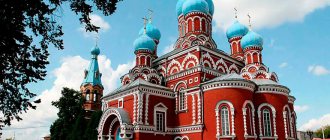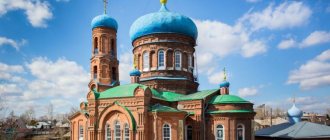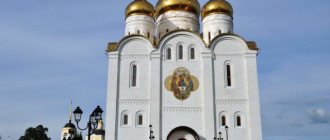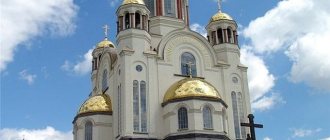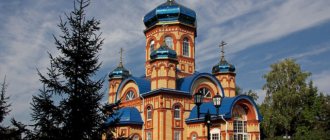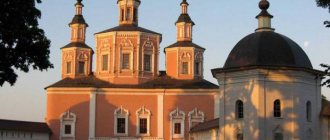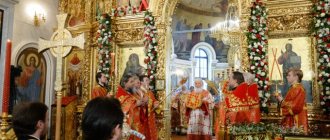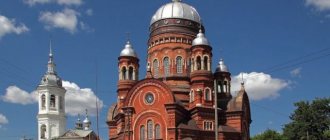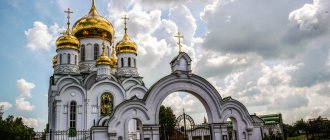The Intercession Cathedral is one of the main attractions of Sevastopol and at the same time an object of increased interest from the believing brethren. It is located in the very center of the city and is visible from anywhere in Sevastopol.
Intercession Cathedral at night, © Haidamac
The temple was erected at the beginning of the 20th century, so that it then went through a lot of crises: it was once the location of a temporary burial vault for the remains of Lieutenant Schmidt and the sailors of the cruiser "Ochakov" who died during the mutiny, a first-aid post, an infectious diseases hospital, a youth sports school, a bomb shelter, the State archive.
The building was also often robbed. There is evidence that over the course of its history, about 40 kg of gold and 100 kg of silver were taken from the cathedral; domes, crosses, bells and some icons were stolen.
Service in the Intercession Cathedral, © Intercession Cathedral VKontakte
History of the deanery
Christian life on the Crimean peninsula began in apostolic times. It is believed that St. Andrew the First-Called and the Equal-to-the-Apostles Slavic enlighteners Cyril and Methodius preached in these parts. And by the end of the 2nd century. There were more than 2,000 Christians on the peninsula, whose communities were located in numerous rock caves.
In the IX-XI centuries. On the territory of the peninsula there were 5 dioceses, the centers of which were located in the ancient Greek city-polises. In 997, in Chersonesus, which is the center of the church unit of the same name, Prince Vladimir was baptized.
St. Vladimir's Cathedral in Tauride Chersonesos
In the 12th century Kherson (Sevastopol) was the cathedral city of an independent diocese. Until the exodus of Orthodox Christians from the peninsula, Kherson was part of the Gothic See.
After the annexation of the Crimean Khanate to the Russian Empire, the lands of the modern Sevastopol deanery were part of large dioceses located in Southern Ukraine and on the Crimean Peninsula. Orthodoxy began to actively develop again in Crimea in 1859, when an independent Tauride diocese was established.
By the end of the 19th century. it becomes the center of Black Sea Orthodoxy. Many Orthodox churches are being built in Sevastopol. Today the Sevastopol deanery is part of the Simferopol and Crimean diocese of the Russian Orthodox Church.
Exterior of the temple
From the outside, the building delights and delights everyone passing by. The temple cannot but surprise with its snow-white walls, skyward arched windows, high-quality kokoshniks and pediments, luxurious stucco molding, and amazing mosaic icons. One gets the feeling that the building is floating in the air and does not touch the ground at all - this 37-meter building looks so light and almost weightless from the outside.
It is also necessary to mention the seven mosaic icons on the facade of the temple. The most revered among them is the icon of the Intercession of the Blessed Virgin Mary, located in the center of the composition. She is always buried in fresh flowers - in this way Orthodox townspeople express their gratitude to the Mother of God for her patronage and protection.
The inside of the shrine also looks the same. All its walls are decorated with paintings, however, there is no feeling of clutter, pressure or heaviness - the prayed-up walls seem to even help you breathe easier. The Intercession Cathedral stores not only icons, but also particles of the relics of the holy Archbishop of Simferopol and Tauride Luke; Admiral Ushakov, who was recently canonized, is also buried here.
The temple is active, so there are always a lot of people in it. Its gates are open to everyone, however, one should not disturb those praying or distract those who serve in the church from the service. Telephone conversations and flash photography are prohibited inside.
© Alexostrov
Deanery districts
The duties of the dean of the Sevastopol district are performed by the rector of the St. Vladimir Church - Archpriest Sergius Khalyuta. He has not only theological, but also secular education:
- medical school (1987);
- Theological Seminary in Odessa (1990);
- Theological Academy in Moscow (2000);
- receiving the scientific degree of candidate of theology (2002).
Archpriest Sergius heads the Sevastopol deanery
In addition to performing the rector's and dean's service, Father Sergius is engaged in teaching at the Tauride Theological Seminary. He embarked on the monastic path in December 1990. Over the years of service, the clergyman has been awarded numerous awards.
Clergy
Deanery clergy refers to both the white and black priesthood. All clergy have a spiritual education, but some of them received secular professions before entering the path of serving the Lord.
- Alexy Tupikov is the rector of the tomb church at St. Vladimir's Cathedral. In 1981, he completed his studies at the Moscow Cooperative Institute. Ten years later he was consecrated by Bishop Vasily of Crimea. In 1998 he received a theological education at the Moscow Theological Seminary.
- Alexander Savichev is the rector of St. Mitrofan's Church. He received his medical education, graduating from the paramedic department of the Crimean Medical College, and then from the psychology department of the Modern Humanitarian Academy in Moscow. He entered the path of priesthood in 1997. He graduated from the regency department of the theological seminary in St. Petersburg.
- Sergius Vovk is the rector of the Church of St. Apostle Andrew the First-Called. In 1993 he graduated from Simferopol State Technical University, and 3 years later he completed his postgraduate studies at the same educational institution. The sacrament of ordination took place in March 1999. A year later he graduated from theological school in Simferopol.
The Sevastopol deanery is concerned about the negativity of parishioners on social networks
On the eve of Christmas, a scandal broke out in Sevastopol because parishioners were not allowed into St. Vladimir's Cathedral for services. Then the press service of the temple explained the situation by saying that late guests were not admitted.
The situation was resolved after the intervention of the Crimean State Duma deputy Ruslan Balbek , who expressed dissatisfaction with what was happening.
However, the Sevastopol deanery expressed concern about the persecution of believers on social networks in connection with the still unresolved issue of free admission of people to St. Vladimir’s Cathedral. This was reported in the press service of the deanery.
At the moment, the management of the Tauride Chersonese Museum-Reserve has proposed finding a compromise solution for the admission of believers to the St. Vladimir Cathedral.
This is, without a doubt, a positive, correct and civilized approach to solving the problem. The Sevastopol deanery will be sincerely glad if a solution that suits both parties is found. But today there is no final algorithm for solving the problem. In addition, we observe with alarm that a real information persecution has unfolded on the Internet in relation to the deanery (or clergy) and believers, concerning the situation on the evening of January 6, when about 100 people were unable to get into the cathedral for the service and, accordingly, to confession, – the press service reports
The document also expressed the opinion that “such information attacks from anonymous people do not contribute to the peaceful resolution of important issues; they are equally painful for the reputation and deanery, and the State Inspectorate of the Tauride Chersonese Museum-Reserve.”
Netizens, reading anonymous messages, think that this is an order from the press service of Tauride Chersonesos, thus casting a shadow on the state structure. So-called fake news has never led to compromise or conflict resolution. The Sevastopol deanery hopes that the management of the museum-reserve will hear the arguments of believers regarding visiting the temple not only on Christian holidays, but also on an ongoing basis.
The opinions of authors and speakers may not coincide with the position of the editors. The editorial position can only be voiced by the editor-in-chief or, as a last resort, by a person whom the editor-in-chief has specifically and publicly authorized.
"INFORMER"
Integrate “INFORMER” into your information flow if you want to receive prompt comments and news:
Subscribe to our channel in Yandex.Zen Add “INFORMER” to your sources in Yandex.News or News.Google We will also be glad to see you in our communities on VKontakte, Facebook, Twitter, Odnoklassniki
← Home
Next news →
Saturday, January 12, 2021 7284
Departments
For effective educational, social and spiritual activities, the following departments operate in the deanery:
- The youth department organizes and coordinates work with the younger generation.
- The Department of Education and Catechesis is engaged in the dissemination and popularization of the spiritual and moral traditions of Orthodoxy.
Temple-pyramid of St. Nicholas in Sevastopol - Deanery employees cooperate with law enforcement agencies and the Cossacks.
- The Department for Combating Alcoholism, Drug Addiction and Other Addictions carries out work aimed at helping addicted people and their families.
- Social work consists of supporting large and low-income families, as well as socially vulnerable categories of the population.
- The pilgrimage department organizes trips to shrines located on the territory of the Deanery and in other Christian lands.
- The department for cooperation with the media is responsible for disseminating information about the work of the deanery.
Churches and temples, monasteries
There are many monasteries and temples on the territory of the deanery. Monastic life develops in the following communities:
- a men's monastery in the name of St. Clement, located in the suburbs of Sevastopol - the city of Inkerman;
- The Holy Transfiguration Monastery, belonging to the Inkerman community, is located in the village. Ternovka;
- Shuldan is a monastery located on a rocky plateau north of Sevastopol;
- cave monastery in the name of St. Savva the Sanctified, located near the village. Ternovka.
Cave monastery of St. Savva the Sanctified in Crimea
The deanery manages about 50 large and small churches. The largest of them are:
- St. Vladimir's Cathedral, built in 1861 on the site of Prince Vladimir's baptism.
- Cathedral in honor of the Feast of the Intercession of the Blessed Virgin Mary, built at the end of the 19th century.
- The Church of the Ascension of the Lord, built in 1905 in memory of the participants in the Crimean War and the defense of Sevastopol.
- The Cathedral of the Holy Chief Apostles Peter and Paul is a unique religious building, reminiscent of a classic ancient Greek temple. The building was erected in 1814. During the Crimean War it was badly damaged and was restored in 1889.
- Church of St. Nicholas the Wonderworker in Kamyshovaya Bay, built at the beginning of the 21st century.
Schedule of services of the Intercession Cathedral
On the official website of the cathedral you can always see the current schedule of services, as well as holidays celebrated by the church. The schedule of services is tied to the Russian Orthodox calendar.
Divine services in the temple are held every day. Morning worship begins at 7 o'clock, at which time the Divine Liturgy is held. At 5 p.m., believers can attend the Evening Service, which takes place at the same time as the Sacrament of Confession. Every day a prayer service and a memorial service are held in the cathedral. On Friday, at 16:00, those who wish can attend a prayer service with an akathist to the Most Holy Theotokos, which is performed in front of the “All-Tsarina” icon.
On weekends, the Divine Liturgy begins at 8 a.m.
© miljkovic14
